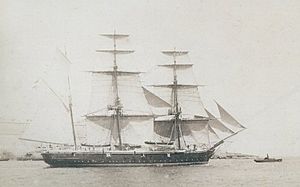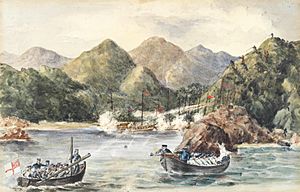HMS Hornet (1854) facts for kids

Hornet's sister ship, Cruizer, shown at Malta in 1894.
|
|
Quick facts for kids History |
|
|---|---|
| Name | Hornet |
| Ordered | 1 November 1850 |
| Builder | Royal Dockyard, Deptford |
| Cost | £29,142 |
| Launched | 13 April 1854 |
| Commissioned | 14 July 1854 |
| Fate | Broken up 1868 |
| General characteristics | |
| Class and type | Cruizer-class screw sloop |
| Displacement | 1,045 tons |
| Tons burthen | 747+51⁄94 bm |
| Length |
|
| Beam | 31 ft 10 in (9.70 m) |
| Depth of hold | 17 ft 6 in (5.33 m) |
| Installed power |
|
| Propulsion |
|
| Sail plan | Barque-rigged |
| Speed | 7.75 knots (14.35 km/h; 8.92 mph) |
| Armament |
|
HMS Hornet was a special kind of warship called a screw sloop. It was built for the Royal Navy in 1854. This ship was designed to use both sails and a steam engine. After serving for many years, it was taken apart in 1868.
Contents
Building a Warship: HMS Hornet
HMS Hornet was part of the Cruizer class of ships. These ships were designed by naval experts like Lord John Hay and Baldwin Walker. Hornet was built at the Deptford Dockyard in June 1851.
This ship had a powerful steam engine. It was a two-cylinder engine that could make the ship go up to 7.75 knots (14.35 km/h; 8.92 mph) (knots). That's about 9 miles per hour! Even with the engine, Hornet also had a full set of sails, like a barque. This meant it could save coal by using wind power.
What Weapons Did Hornet Carry?
Hornet was armed with several cannons. It had one large 32-pounder gun on a special mount that could turn. This was called a pivot gun. It also had sixteen other 32-pounder guns placed along its sides. These were called carriage guns.
Hornet's Adventures at Sea
HMS Hornet had an exciting career serving in different parts of the world. It took part in the Crimean War in 1854. Later, it sailed to the East Indies and China, where it was involved in the Second Opium War.
Fighting in the Baltic Sea (1854)
In 1854, Hornet was sent to the Baltic Sea. It joined other British ships during the Crimean War. This war involved Britain and its allies fighting against Russia.

Exploring the East Indies and China (1854-1856)
While serving in the East Indies, Hornet made an interesting discovery. On April 25, 1855, along with two other ships, it found some small islands. These islands are now known as Liancourt Rocks in the Sea of Japan.
The Second Opium War (1856-1859)
Hornet played a big role in the Second Opium War in China. On November 12, 1856, it joined other British warships to attack and capture the Bogue forts. These were important forts guarding the entrance to Canton (now Guangzhou).
Hornet spent Christmas 1856 guarding Canton. In 1857, it was often in Hong Kong and the Canton River. Its service there ended with the capture of Canton on December 28, 1857. After these events, Hornet sailed back to England in February 1859.
Serving in Africa and Asia (1860-1864)
In 1860, Hornet was sent out again. This time, it served on the Cape of Good Hope Station near Africa. It also spent time on the East Indies Station, continuing its duties in Asia.
End of Service
HMS Hornet finished its active service on September 22, 1864. It was then taken apart in 1868.
Commanding Officers
Here are some of the captains who commanded HMS Hornet:
| From | To | Captain |
|---|---|---|
| 15 May 1854 | 13 September 1854 | Commander Frederick Archibald Campbell |
| 13 September 1854 | 1857? | Commander Charles Codrington Forsyth |
| January 1857 | 26 February 1858 | Commander William Dowell |
| 26 February 1858 | 14 July 1859 | Commander Lord Gilford |
| 20 July 1860 | 3 May 1861 | Commander William Buller Fullerton Elphinstone |
| 3 May 1861 | 1864? | Commander Joseph Dayman |
| 1864? | 12 September 1864 | Acting Commander Richard Hare |


